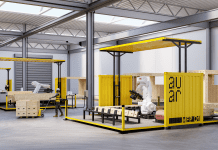Britain must leverage the use of construction robotics and automation or risk being left behind on the global landscape, the National Roboatrium’s Pete Felton writes
The construction industry worldwide is on the brink of a groundbreaking transformation, as robotics and artificial intelligence (AI) are set to revolutionise traditional building processes.
The global robotics market is projected to experience a threefold increase, rising from $72 billion in 2022 to an impressive $283 billion by 2032. Within this broader context, market projections indicate a staggering growth in the construction robotics sector, with an expected value of $682 million by 2028. This surge is fueled by the increasing demand for intelligent, secure, and durable structures.
Since the National Robotarium last spoke with PBC Today a little over two years ago, shedding light on the abundance of AI, robotics, and data solutions available to the sector, the construction industry has witnessed a remarkable transformation – not only embracing these technologies but has also making significant advancements in integrating robotics solutions across various stages of the construction process.
From autonomous cranes to robots that lay bricks, cutting-edge technologies are overhauling construction methods from the foundation up. The benefits are already evident, with improved efficiency, eco-friendliness, and most crucially, enhanced safety measures. By taking on hazardous tasks, accelerating repetitive work, generating real-time digital replicas of construction sites, and facilitating the creation of environmentally conscious buildings, robots and AI are preventing worker accidents and injuries.
Importantly, they also demonstrate the industry’s commitment to leveraging cutting-edge technologies to overcome long-standing challenges and pave the way for a more innovative and sustainable future.
Empowering builders with superhuman strength
One such example is Ekso Bionics, a California-based company that has created robotic exoskeletons designed to seamlessly integrate with workers’ bodies. These bionic suits distribute the weight of heavy tools, such as jackhammers and cement drills, preventing concentrated strain on shoulders, arms, and backs that can result from repetitive tasks.
Equipped with sensors, these exoskeletons move in perfect harmony with the builders, minimising the risk of injury and allowing them to work efficiently for extended periods without muscle fatigue. With the ability to increase human strength by up to 15 pounds, these suits enable safer handling of heavy-duty tools and reduce the likelihood of accidents on construction sites.
Drilling with precision
In addition to enhancing safety, construction robotics is also revolutionising productivity at facilities. Hilti’s semi-autonomous Jaibot system, for instance, is making significant strides in this area. By consulting a project’s detailed Building Information Modeling (BIM) scans, Jaibot determines the precise drilling locations for each column and self-navigates to the correct position, efficiently carrying out installation procedures without the need for human direction.
Capable of completing over 500 holes per charge and working autonomously for up to 8 hours, Jaibot allows workers to focus on more complex activities while accelerating mechanical, electrical, and plumbing workflows. Similar innovations in steel beam placement, bricklaying, and modular construction are also contributing to faster completion of core building processes, drastically improving project timelines.
Building a greener future
The integration of robotics with BIM technology is also opening new avenues for optimising the sustainability of buildings throughout their entire life cycles. By leveraging digital twin data and climate forecasts, energy analysis algorithms can model a structure’s thermal properties over decades. This enables engineers to instantly assess how factors like insulation placement may impact heating across floors and make digital adjustments before physical construction begins.
Robots further support this process by automating the installation of energy-efficient components such as ductwork, solar panels, and automated windows that regulate light and heat flow. The BIM-based digital twins then guide easy retrofit improvements in the future as technologies advance or climate considerations change, ensuring that buildings remain sustainable and adaptable.
Automating construction progress
Moreover, cutting-edge mapping robots, such as Boston Dynamics’ Spot, are revolutionising construction progress monitoring through digital twinning. With integrated LIDAR sensors and Simultaneous Localisation and Mapping (SLAM) technology, Spot can autonomously navigate facilities overnight, gathering updated 3D spatial data. This data is then used to create intricate digital mesh models that provide a real-time representation of the structure’s development.
By comparing these digital twin overlays with BIM blueprints, site managers can quantify daily advancement rates and identify areas where additional human intervention may be necessary to maintain progress. Digital twins also facilitate compliance verification across power, water, and ventilation systems in rapidly evolving builds, while providing lifetime visibility into concealed infrastructure, aiding future retrofitting, maintenance, and operational efficiency.
Enhancing productivity
Robots are also excelling at taking over monotonous construction tasks, such as overhead hammer drilling and repetitive heavy material transport. These tasks not only prove tedious for human workers but also pose risks of long-term health issues due to exposure to loud noise, dust, and potential muscular damage.
Advanced robotic systems, like the Semi-automated Mason, can perform these repetitive tasks with unparalleled precision, without fatigue or compromising safety. Equipped with hook attachments, these robots can pick, place, and grout blocks in bricklaying tasks, allowing builders to focus on jobs that specifically require human dexterity, creativity, and oversight. The synergy between workers and robotics significantly boosts productivity on construction sites.
Looking to the future of construction robotics
As the benefits of construction robotics become increasingly apparent, it is imperative that the industry continue to adopt these technologies rapidly. The National Robotarium, in partnership with organisations like BE-ST (Built Environment—Smarter Transformation), is at the forefront of driving this change. By bringing together key stakeholders through events such as ‘The Robots are Here,’ the National Robotarium aims to foster collaboration and develop innovative robotic solutions that address real-world challenges in the construction sector.
The future of construction lies in the successful integration of robotics and human expertise. As the industry embraces this robotic revolution, we can expect to see significant improvements in safety, efficiency, sustainability, and productivity. The National Robotarium stands ready to work hand in hand with the construction industry to develop cutting-edge robotic technologies that will reshape the way we build, paving the way for a smarter, safer, and more resilient built environment.
















